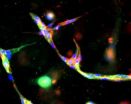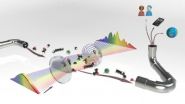(Press-News.org)
VIDEO:
New research from the Bradley Hasbro Children's Research Center may help clinicians better predict how a child with obsessive compulsive disorder (OCD) will respond to some of the most commonly...
Click here for more information.
EAST PROVIDENCE, RI – New research from the Bradley Hasbro Children's Research Center may help clinicians better predict how a child with obsessive compulsive disorder (OCD) will respond to some of the most commonly used treatment approaches. The findings, published in the October issue of the Journal of the American Academy of Child and Adolescent Psychiatry, could help guide important clinical decisions about the best intervention for children with this often debilitating anxiety disorder.
"Until now, there has been little information about which OCD treatment to recommend to particular pediatric patients," said lead author Abbe Garcia, PhD, director of the Bradley Hasbro Children's Research Center (BHCRC) Pediatric Anxiety Research Clinic. "Our study identified some characteristics of children with OCD that could help us predict which patients are most likely to benefit from particular treatments, similar to a personalized medicine approach."
OCD is an anxiety disorder characterized by recurrent, unwanted thoughts (obsessions) and/or repetitive behaviors (compulsions). The symptoms reported by children are similar to those seen among adults with OCD. According to the American Academy of Child and Adolescent Psychiatry, as many as 1 in 200 children and adolescents struggle with OCD.
Researchers focused on outcomes of the three most commonly used treatment approaches for pediatric OCD: a form of psychotherapy known as cognitive behavioral therapy (CBT) that teaches children to face their fears; sertraline, a selective serotonin reuptake inhibitor (SSRI); and a combination of the two.
They found that children with less severe OCD symptoms, fewer co-existing behavior problems and children whose symptoms cause less impairment in their everyday lives showed greater improvement across all of the treatments. Also, children who were better able to recognize their symptoms as irrational fared better, regardless of the treatment course. In addition, patients from families that were less accommodating of the child's OCD symptoms were also more successful in all treatments.
The study also revealed an intriguing connection between OCD treatment outcome and family history: patients with a parent and/or sibling with OCD did six times worse in CBT than their peers without a family history of OCD. Garcia says this could be due to the nature of CBT, which requires more family support and at-home involvement than medication compliance, something that could be more difficult when a parent or other sibling is also dealing with OCD.
"Based on our findings, cognitive behavioral therapy with or without a concomitant medication is the treatment of choice for children and teens with OCD who do not have a parent or sibling who is also affected," said Garcia. "For those children with a family history, cognitive behavioral therapy in combination with a medication is probably the most effective treatment approach."
The study included 112 children between the ages of 7 and 17 with a primary diagnosis of OCD but who were not currently being treated. The group included roughly even amounts of males and females as well as younger and older children. All participants were randomly assigned to one of four treatment approaches: CBT and setraline; setraline; CBT only; and a placebo. Researchers analyzed how children responded after 12 weeks of treatment using the Children's Yale-Brown Obsessive Compulsive Scale, a clinical tool used to measure a patient's level of impairment and distress.
INFORMATION:
Garcia is also on the faculty of The Warren Alpert Medical School of Brown University. Other researchers involved in the study, which was funded by the National Institute of Mental Health, included Jennifer Freeman, PhD, also of the Bradley Hasbro Children's Research Center and Alpert Medical School; Jeffrey J. Saptya, PhD, Phoebe S. Moore, PhD, and John S. March, MD, MPH, from Duke University Medical Center; and Martin E. Franklin, PhD, and Edna B. Foa, PhD, from the University of Pennsylvania School of Medicine.
About Bradley Hospital
Founded in 1931, Bradley Hospital, located in East Providence, RI, was the nation's first psychiatric hospital devoted exclusively for children and adolescents. It remains a nationally recognized center for children's mental health care, training and research. Bradley Hospital is a member of the Lifespan health system and is a teaching hospital for The Warren Alpert Medical School of Brown University. For more information, please visit www.bradleyhospital.org
New research helps clinicians predict treatment outcomes for children with OCD
Findings could help guide clinical treatment decisions
2010-10-15
ELSE PRESS RELEASES FROM THIS DATE:
University of East Anglia makes cancer breakthrough
2010-10-15
Scientists at the University of East Anglia have made an important breakthrough in the way anti-cancer drugs are tested.
A tumour cannot grow to a large size or spread until it has developed its own blood supply and leading research has looked for a way of halting capillary formation to stop tumours taking hold.
But new findings published today in the Journal of Cell Science have shown that scientists testing such treatments may not have been studying exactly what they thought they were.
The research proves that cells are able to switch their genetic profile – ...
OCTANE study influences revision of WHO guidelines for treating some HIV-infected women
2010-10-15
Findings from a study, which appear in the Oct. 14, 2010 New England Journal of Medicine, helped influence the World Health Organization (WHO) to change its guidelines this year for the treatment of HIV-infected women who receive a single dose of the antiretroviral drug nevirapine to prevent HIV transmission to their babies. The study demonstrated that the single dose of nevirapine used to prevent mother-to-child transmission of HIV can hamper the drug's effectiveness if it is also used later as part of a regimen to treat these same individuals.
The Phase III study, called ...
Biomarker shows potential for early diagnosis of lung cancer
2010-10-15
CHAPEL HILL, NC – A collaboration between physicians and scientists at UNC Lineberger Comprehensive Cancer Center and the University of Texas M.D. Anderson Cancer Center has demonstrated that a biomarker called TCF21 may be used to develop a potential screening test for early-stage lung cancer.
Despite the fact that lung cancer is the leading cause of cancer deaths worldwide, early-stage lung cancer is difficult to diagnose. A number of proposed screening tests, including screening CT scans and serum markers, have not shown any benefit in enhancing patient survival.
TCF21 ...
Not all doctors follow cancer screening guidelines
2010-10-15
Only one-fifth of primary care physicians in the US follow practice guidelines for colorectal cancer screening for all the tests they recommend, according to Dr. Robin Yabroff from the National Cancer Institute and her colleagues. About 40 percent followed guidelines for some of the tests they recommended and the remaining 40 percent did not follow guidelines for any of the screening tests they recommended. Furthermore, their analysis1 of physician screening recommendations for colorectal cancer shows that many clinicians either overuse or underuse screening. Their findings ...
Orchid tricks hoverflies
2010-10-15
Even Darwin was a self-admitted orchid lover. Dictionaries describe orchids as exotic ornamentals. Indeed, these plants – more than 30000 different species are thought to exist – are exotic due their extraordinary and diverse flower morphology. However, they are also exotic from a point of view other than beauty: as crafty imposters in order to achieve reproduction and to make sure that their ovaries are pollinated. Orchids depend on the assistance of pollinators, and like many other flowering plants, attract insects.
Epipactis veratrifolia, an orchid native in South ...
The kids are all right: Few negative associations with moms' return to work after having children
2010-10-15
WASHINGTON – Children whose mothers return to work before their offspring turn 3 are no more likely to have academic or behavioral problems than kids whose mothers stay at home, according to a review of 50 years of research.
"Overall, I think this shows women who go back to work soon after they have their children should not be too concerned about the effects their employment has on their children's long-term well-being," said psychologist Rachel Lucas-Thompson, PhD, lead author of the study conducted with Drs. JoAnn Prause and Wendy Goldberg at the University of California, ...
Study: Belief in rumors about proposed NYC mosque linked to opposition to all mosques
2010-10-15
COLUMBUS, Ohio – People who believe false rumors about the proposed Islamic cultural center and mosque near Ground Zero in New York City not only are more likely to oppose that project – they are more likely to oppose building of a mosque in their own neighborhood.
Researchers surveyed 750 Americans and asked them if they believed any of four rumors associated with the New York City mosque, all of which have been refuted. One of the rumors, for example, falsely says that that the proposed center is scheduled to open on September 11, 2011 in celebration of the 10-year ...
Large gaps found in public understanding of climate change
2010-10-15
New Haven, Conn.—Sixty-three percent of Americans believe that global warming is happening, but many do not understand why, according to a national study conducted by researchers at Yale University.
The report titled "Americans' Knowledge of Climate Change" found that only 57 percent know what the greenhouse effect is, only 45 percent of Americans understand that carbon dioxide traps heat from the Earth's surface, and just 50 percent understand that global warming is caused mostly by human activities. Large majorities incorrectly think that the hole in the ozone layer ...
JILA unveils improved 'molecular fingerprinting' for trace gas detection
2010-10-15
Scientists at JILA and collaborators have demonstrated an improved laser-based "molecular fingerprinting" technique that picks out traces of key hydrogen-containing and other molecules from a billion other particles in a gas in just 30 seconds or less—performance suitable for breathalyzers for diagnosing disease, measuring trace gases in the atmosphere, detecting security threats and other applications.
JILA is jointly operated by the National Institute of Standards and Technology (NIST) and University of Colorado at Boulder (CU).
Described in Optics Express,* the research ...
CR Magazine sheds light on the burden of cancer on the streets
2010-10-15
PHILADELPHIA — An article published in the Ffall 2010 issue of CR, the AACR's magazine for cancer survivors and their families and caregivers, details the immense challenges faced by those who suffer with cancer and lack the necessary resources for proper treatment and care — the homeless.
CR magazine contributing writer Cynthia Ryan, Ph.D., who is an associate professor of English at the University of Alabama at Birmingham, took to the streets over the last year to offer a glimpse into the lives of homeless cancer patients struggling to obtain treatment while being ...
LAST 30 PRESS RELEASES:
How to make AI truly scalable and reliable for real-time traffic assignment?
Beyond fragmented markets: A new framework for efficient and stable ride-pooling
Can shape priors make road perception more reliable for autonomous driving?
AI tracks nearly 100 years of aging research, revealing key trends and gaps
Innovative techniques enable Italy’s first imaging of individual trapped atoms
KIER successfully develops Korea-made “calibration thermoelectric module” for measuring thermoelectric device performance
Diversifying US Midwest farming for stability and resilience
Emphasizing immigrants’ deservingness shifts attitudes
Japanese eels, climate change, and river temperature
Pusan National University researchers discover faster, smarter heat treatment for lightweight magnesium metals
China’s 2024 Gastroenterology Report: marked progress in endoscopy quality and disease management
Pusan National University researchers uncover scalable method for ultrahigh-resolution quantum dot displays
Researchers use robotics to find potential new antibiotic among hundreds of metal complexes
Gut bacteria changes at the earliest stages of inflammatory bowel disease
Scientists develop new way to “listen in” on the brain’s hidden language
Brain research: “Pulse generators” grow and shrink as memories are formed
For teens, any cannabis use may have impact on emotional health, academic performance
School meals could unlock major gains for human and planetary health
Menopause hormone therapy does not appear to impact dementia risk
Signature patterns of brain activity may help predict recovery from traumatic brain injury
Dresden study uncovers new key mechanism in cancer cells
New species are now being discovered faster than ever before, study suggests
Cannabis-based products show limited short-term benefit for chronic pain, with increased risk of adverse effects
Cannabis products with more THC slightly reduce pain but cause more side effects
Clearing the brain of aging cells could aid epilepsy and reduce seizures
Brain injuries linked with potential risk of suicide, new study finds
New technique lights up where drugs go in the body, cell by cell
New study finds movement of fishing fleets can reveal shifts in marine ecosystems
Embargoed: New evidence points to potential treatment for vascular dementia
Study uncovers disrupted brain balance in alcohol dependence
[Press-News.org] New research helps clinicians predict treatment outcomes for children with OCDFindings could help guide clinical treatment decisions



